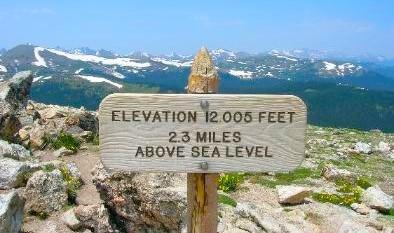How exactly does altitude sickness affect the body and will it affect me if I am in good physical shape? These are fantastic questions and the answer is based on several factors. Honestly, even if you are in top physical condition you can still get altitude sickness. Some people do not reach elevation in a safe way and others are genetically predisposed to it. Let’s get into it.
Altitude Sickness
Altitude sickness usually can occur at 8,000 ft / 2,500 meters above sea level. There are fewer oxygen molecules in the air at high levels and the body responds with symptoms of sickness. The biggest danger is when individuals rise to high levels without allowing their body enough time to acclimate. There is a possibility of fluid entering the lungs if the body is not given enough time to adjust. A number of factors contribute to the extent to which altitude sickness may occur. These include:
- Physical condition
-
- weight
- blood pressure
- physical fitness
- age
-
- How quickly elevation occured
- Amount of time spent at elevation
The mildest symptom is a headache and dehydration. More several symptoms are:
-
-
-
- Dizziness
- Shortness of breath
- Insomnia
- Weakness
- Loss of appitite
- Pins and needles
- Swelling
- Low energy
- Vomiting
- Disorientation
- Loss of consciousness
-
-
It is estimated that about 50% of people who travel from sea level to 14,000 feet will be affected by altitude sickness. Also, certain genetic factors contribute to the likelihood of sickness. There are 2 specific genes that have been found that greatly increase the chance of sickness. Even physically fit people are at risk and should take precautions.
The higher the elevation and the longer time spent, the more severe symptoms become. Breathing at 18,000 feet contains half the oxygen than at sea level. This is because there is less pressure in the atmosphere bonding oxygen molecules together. At sea level oxygen has a pressure of about 159 mmHg and at 26,000 feet it is only 53mmHg. With the decreased oxygen, the body responds by increasing breathing and increased heart rate.

Fluid can build in the lungs as tiny blood vessels begin to leak due to the stress in the body and lack of oxygen. This is most common in people who live at sea level and travel to high altitudes. There are several stages to altitude sickness with the more severe resulting in eye nerve damage or swelling and fluid in the brain. The most severe types can be deadly if not treated immediately.
Prevention
To prevent and help control altitude sickness slowly rise to higher elevations to allow for acclimation. The body needs 2-3 days to adjust to increasing altitudes so go very slow during this period. If mild symptoms such as a headache, dizziness or increased breathing begin, slowly descend and allow the body some time before reattempting at a slower pace.
Smoking can increase this risk so avoid it and drink plenty of fluids. Increase fluids to 5-7 liters per day to help the body stay hydrated. The body’s metabolism is also increased at elevation so it is best to consume a larger number of calories to maintain efficient energy and nutrition.

If symptoms persist, seek out an oxygen mask that is commonly provided at hotels and businesses at high elevation. They can also be purchased and kept with you during ascent. There are also several different medications that can relieve and manage symptoms. They must be provided by a doctor.
Physical Health
With the lack of oxygen and stress on the body in high altitude, any physical activity will be more difficult. Since there are genetic as well as biological factors involved, it is impossible to know who will be affected and how severely. People born and living in high altitudes have a larger lung capacity and use oxygen more efficiently. It is not fully known whether this is genetic or an adaptation of the body.
Exercising or physically straining the body within the first 3 days of being at elevation greatly increases the risk of sickness. No matter how physically fit or trained you are, take it slow and relax so the body can adapt. If running 3 miles is normal then try running 1 to see how it feels. General physical stamina is dramatically reduced at high elevation and it is not advisable to push the body.
Training masks
These masks are very popular with certain athletes. They mimic the effects of high altitude by limiting oxygen and forcing the heart and lungs to work harder. Right now, the scientific studies are mixed about how effective it actually is. However, the premise is that by training in an extreme state with the mask, athletes are more advantaged during competition. The more intense training is the easier normal fitness becomes. Get yours HERE.
Also, any athletes that compete in high altitudes gain an advantage by preparing with the mask. It gives their bodies an opportunity to learn how to cope with reduced oxygen levels while exercising. Training masks are also said to increase mental control and concentration. There are some risks with training masks including hyperventilating, fatigue or fainting.
Lastly
No matter how physically fit a person is, there is always a risk for altitude sickness. While being fit does lessen the likelihood it is not a guarantee. Using training masks may help the body manage the elevation and is a great tool for athletes who compete. Follow all precautions and ensure that the body is brought to elevation in a safe and educated way. Rest as much as needed and stay hydrated.



